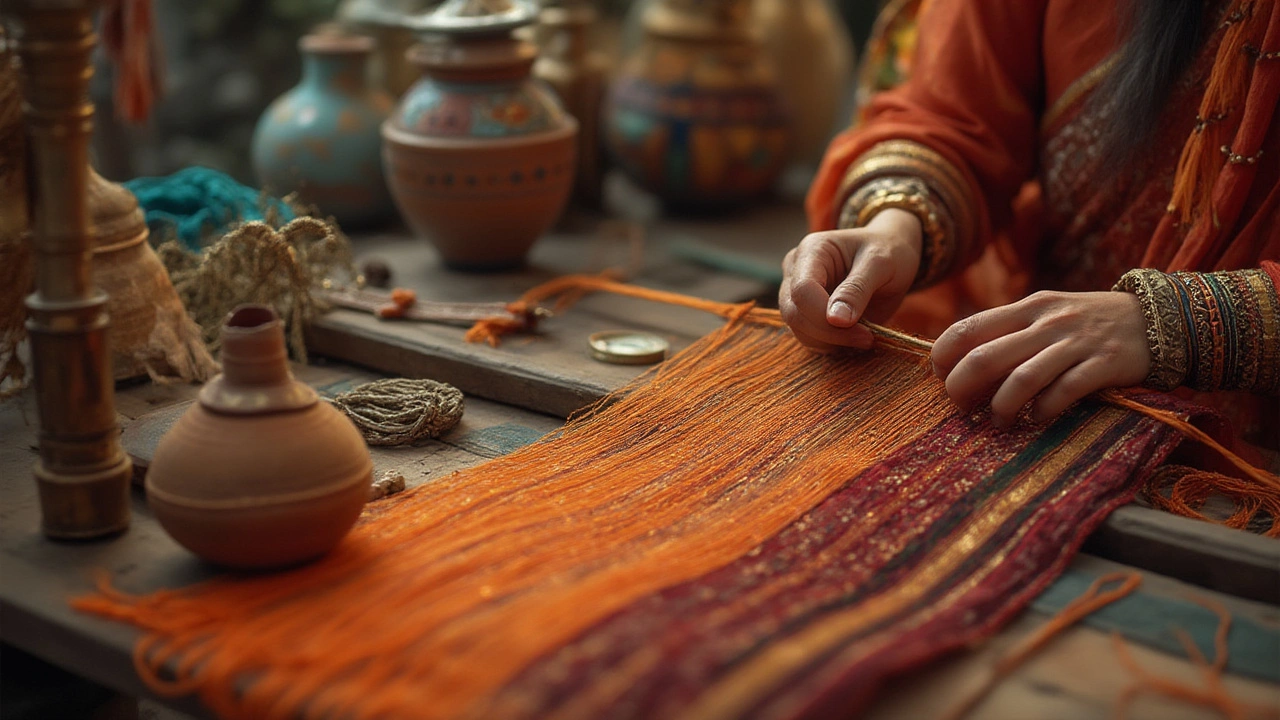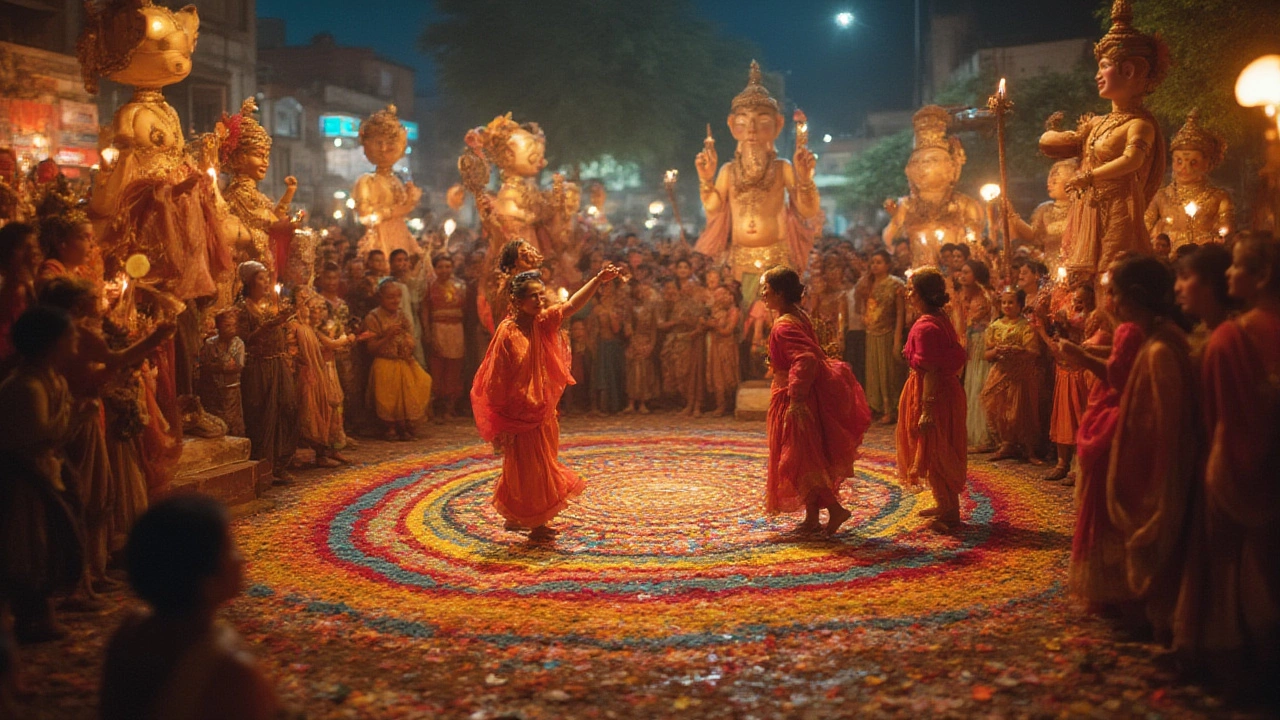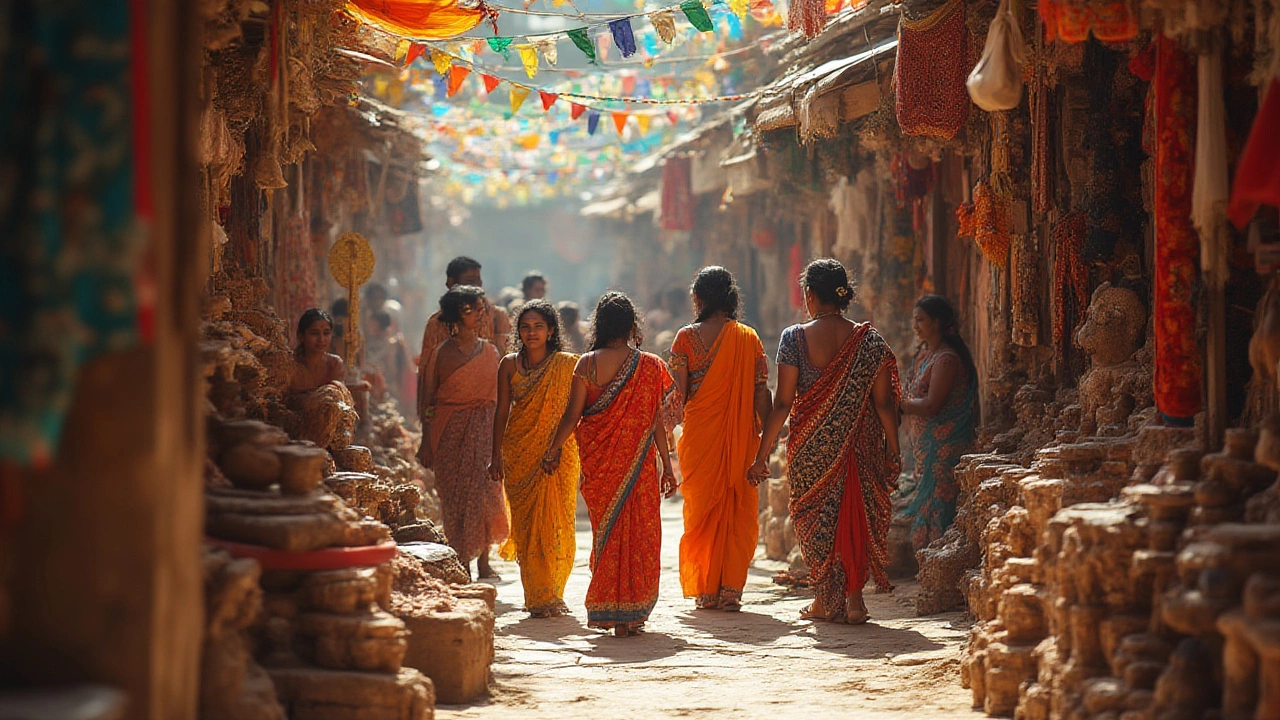Walking through the bustling lanes of Pune during Ganesh Chaturthi, with bright statues of Ganesha staring back at you from every corner, you start wondering—how did Maharashtra end up with such a mix of art styles and creative energy? This state isn't just about Bollywood and beaches. It's a living museum, busy at work, where past and present mix in everything you see: earthen pots painted with wild vines, silk-path saris draped on mannequins, and festival pandals crafted by local genius. Art here refuses to sit quietly on gallery walls. It’s part of daily life, often right under your nose.
Maharashtra’s Art: A Living Tapestry Woven through Centuries
Maharashtra doesn’t just wear its history; it paints it, molds it, and dances it. Stretching from the thunderous waves of Konkan to the dusty lanes of Vidarbha, the art forms born here come soaked in local flavor. At first glance, these traditions might seem like random pops of color—a Warli mural splashed across a clay wall or a Paithani sari glimmering in a window. But look closer, and there’s a story under every brushstroke and stitch, built on centuries-old roots.
Let’s start with some ground facts. Maharashtra covers nearly 309,000 sq km, making it the third largest state in India, and boasts a dizzying array of communities. Each valley or coast seems to spin its own legend. This shows up in what people make. The painted devghar shrines in homes; the chitrakathi scrolls still carried by bards in Sindhudurg; the clusters of pottery villages near Nashik; the little elephant figurines crafted in Pen—each piece maps a different region’s way of seeing the world.
Art here loves company. You rarely see it alone. Think of the grand Pandharpur Wari, with tens of thousands journeying to Lord Vitthala, decked out in bright abhang music, painted palkis, and flowering turban-head-bands. Or Ganesh Chaturthi, where sculptors might start making clay idols months in advance, working long nights, swapping tips on how to work the soft river clay so it doesn’t crack when it bakes. Some families have been sculpting Ganeshas since the late 19th century!
The local festivals themselves become live art galleries: the Palkhi processions, Holi, Gudi Padwa. Even daily street life in Mumbai churns out graffiti and stencil art. Back in the day, Raja Ravi Varma visited Baroda and Mumbai, blending European and Indian techniques, inspiring generations of Maharashtrian portrait artists. Today, urban art students in Pune graffiti old mill walls with digital-age murals that go viral online, adding a new twist to folk traditions.
What keeps this all ticking? It’s not just pride—it’s adaptability. Maharashtra’s artists seem to treat rules as flexible suggestions. Modern Warli artists may switch from rice paste to acrylic. Paithani weavers might use power looms but still finish hard bits by hand. During the lockdown, rural sculptors even started streaming idol-making tutorials online to keep business alive. Now, that’s creative survival.
The stats show how seriously people take these crafts. According to a 2023 government survey, more than 180,000 families in Maharashtra are directly involved in traditional arts and crafts. Production of Paithani sarees, the pride of Yeola, rose by nearly 20% since 2018, helped by online marketplaces. Last year’s Ganesh idol industry in Pune alone saw over 5,000 workshops selling more than 140,000 idols each season. It’s not just heritage—it’s economic lifeblood.

Signature Styles: What Sets Maharashtra’s Art Apart?
If you ask Vikram, my kid, what art from Maharashtra means, you’ll probably get one answer—"Warli!" This tribal art might be the state’s best-known face, springing from the Adivasi villages in northern Sahyadris. Warli artists don’t use fancy oils or dozens of colors. They rely on rice paste and ochre-red mud, sketching with a pointed bamboo stick. But what magic! Circles and triangles turn into scenes of hunting, farming, or wild village dances. Designs hand down wisdom: a spiral reflects life’s movement, two hands facing each other signal community. Over 2,500 years old, Warli painting only got ‘discovered’ by city folks after 1970. Today it’s on everything from five-star hotel walls to phone cases on Amazon.
Scoot southwest, and you’ll find Chitrakathi storytellers spinning Myths of Ramayana in gorgeous, hand-painted scrolls. Tiny pockets near Pinguli keep this endangered art alive. Each scroll acts like a comic strip minus the speech bubbles. In Solapur, wall-hanging weavers make bright phads and Godhadi quilts—traditional patchwork blankets, often made from old saris. Grandma’s favorite bedtime story might be stitched right into the fabric, if you look closely enough.
Maharashtra is also sari-obsessed. The lustrous Paithani saree—a must-have in many brides’ trousseaus—dates to at least the 2nd century BCE, crafted from fine silk with motifs of peacocks, lotuses, and vines. Real Paithani has no ‘wrong’ side; both look the same, thanks to laborious two-person weaving. It can take a year or more to stitch a masterpiece. Chanderi, Narayan Peth, and Himroo are other fabrics woven with similar devotion but different regional spins.
Jewelry-making is another art form that bursts with detail. Kolhapuri saaj necklaces sometimes have twenty-one tiny pendants, each loaded with meaning—protective amulets, lucky symbols, or tributes to regional gods. Then there’s Bidriware, a dark, zinc-copper alloy inlaid with pure silver, perfected in Aurangabad and often gifted at weddings. Not to forget the classic Bangles from Sholapur, worn during marriages, unique for their bright glass-and-lac finish.
The art doesn’t just sit on fabric and walls—it floods homes and streets. In Diwali season, every doorway in a Maharashtrian village is dappled with Rangoli powder: geometric sunbursts, flowers, peacocks, and sometimes witty slogans. It’s art for Goddess Lakshmi to tread on. During Gudi Padwa, new year banners and handmade garlands take over Mumbai’s skyline. Even sugar is turned into edible art: massive mounds of Puran Poli and modak sweets, shaped and colored by hand for every festivity.
Take a drive toward Ajanta and Ellora, and suddenly you’re swallowed up by the deafening quiet of the world’s largest rock-cut temples. The ancient cave frescoes (dating back to 2nd century BCE) show not just religious scenes, but lively bits of then-day life—traders, dancers, musicians—painted in earth-based pigments that still glow 2,000 years later. Historians argue the Ajanta caves inspired later Mughal miniatures and Rajasthani frescoes. Even today, devotees try to copy these motifs when painting shrines at home.
Music and dance slip into art too. Lavani is Maharashtra’s own high-energy, foot-stomping dance, famous for its bright costumes and bold, expressive gestures. Dholki drummers, called Dhangars, turn festival crowds into instant dance parties. Tamasha theatre, full of drama, comedy, and riotous set-paintings, pops up in village fairs, throwing the spotlight on everything from politics to local gossip.
So, what sets Maharashtra apart? It’s the tight link between tradition and improvisation. Today’s urban muralist might borrow tricks from Warli; Mumbai fashionistas sport Paithani scarf-wraps with jeans; rural kids paint rangolis with glow-in-the-dark chalk. Each style gets tweaked, but never erased. That’s the secret sauce.

Tangible Heritage: Artisans, Craft Markets, and Everyday Creativity
It’s easy to think that traditional art means old-school folks tucked away in dusty homes. Spend a weekend in Maharashtra, and you’ll realize—craft here is alive, kicking, and entrepreneurial. Local artisans flood weekend bazaars, Ganesha-idol fairs, and Diwali pop-up stalls. In Nashik’s pottery village, you can watch families coax a lump of clay into a lamp or a tiny bull, sometimes refining a single design for generations. Pen, near Mumbai, churns out lakhs of eco-friendly Ganesh idols, shipped across India and even to the US for the Maharashtrian diaspora.
Mumbai’s Kala Ghoda Arts Festival draws crowds over half a million strong. Kids from slum art clubs display hand-painted bookmarks. Celebrity artists run workshops for teens. In rural markets, you’ll see basket-weavers managing payments on smartphones, ready for the next market order. From Kolhapur’s chappal-makers to Khandesh’s bamboo toy shops, people blend age-old skill with today’s tools—WhatsApp orders, YouTube demos, and e-wallets. That’s modern Maharashtra art, refusing to freeze in time.
Want art in your home? Here are some tips: For the real Paithani, scout Gharkul shops in Yeola, or get in touch with master weavers through government-run websites like Maharashtra State Handloom Corporation. Genuine Warli artists work around Dahanu and Palghar; buy direct from artist collectives, or visit artisan-led exhibitions held in Mumbai’s cultural centers. If you’re keen for stone or woodcraft, Pune, Aurangabad, and Nagpur have old families doing business for decades—always ask for their family story, they love to share!
| Art Form | Primary Region | Special Feature |
|---|---|---|
| Warli Painting | Palghar, Dahanu | Tribal motifs, rice-paste on red mud |
| Paithani Sarees | Yeola | Reversible silk, peacock motifs |
| Chitrakathi | Sindhudurg | Hand-painted scroll storytelling |
| Bidriware | Aurangabad | Silver inlay on dark metal |
| Godhadi Quilts | Solapur | Patchwork of old sarees |
| Rangoli | State-wide | Colorful patterns for festivals |
| Clay Ganesh Idols | Pen, Pune | Eco-friendly, crafted for Ganesh Chaturthi |
| Kolhapuri Chappals | Kolhapur | Leather footwear, hand-stitched |
Some quick ideas for travelers: If you’re near Mumbai in August-September, don’t miss the avalanche of homemade Ganesh idols. Pune, in summer, hosts over 200 art workshops—try hands-on Batik painting or ceramic glazing. Nagpur has fairs showing rare brass Dokra work. And if you’re hunting for the authentic Village India experience, aim for the lesser-known villages in Palghar or Sindhudurg—these are the roots of the Maratha Empire, humming quietly with creativity.
Young Maharashtrians are bringing tradition online, too. Check out art collectives like Tribal Route, which connects tribal and urban artists, or Truepaithani, championing new-age weaves and sustainable production. Social media is awash with workshops, live demos, and interviews. If you’re feeling ambitious, even simple kids’ projects—like making your own rangoli with Vikram—can get you dabbling in a 2,000-year-old tradition.
It’s all about celebrating what’s raw and real. No sterile velvet rope separates art from life. In Maharashtra, artists aren’t just creators—they are friends, neighbors, mentors. Their crafts—shaped by hand and heart—invite you to step right in and become part of the story.
